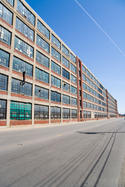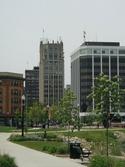Once upon a time, not so long ago, in a city at the heart of the American continent, General Motors produced cars, like Pontiac’s “Little GTO,” celebrated in Beach Boys songs that captured the thrill of driving Detroit’s latest creations. Today, as GM struggles to appease the government’s auditors just to stay alive, Kris Kristofferson, with a little help from Mickey Rourke, curses the financial wizards from Wall Street that are “Shutting Detroit Down” while “livin’ it up in that New York town.” read more »
Economics
Here in the Real World They’re Shutting Detroit Down
The Worst Cities for Job Growth
One of the saddest tasks in the annual survey of the best places to do business I conduct with Pepperdine University's Michael Shires is examining the cities at the bottom of the list. Yet even in these nether regions there exists considerable diversity: Some places are likely to come back soon, while others have little immediate hope of moving up. (Please also see "Best Cities For Job Growth" for further analysis.)
The study is based on job growth in 336 regions – called Metropolitan Statistical Areas by the Bureau of Labor Statistics, which provided the data – across the U.S. Our analysis looked not only at job growth in the last year but also at how employment figures have changed since 1996. This is because we are wary of overemphasizing recent data and strive to give a more complete picture of the potential a region has for job-seekers. (For the complete methodology, click here.)
Is That an Economic Light at the End of the Tunnel or an Oncoming Train?
When it comes to the state of the economy, is the worst behind us or still to come? Informed opinion is all over the map. The optimists are citing such factors as accommodative Federal Reserve Bank policy (massively increased liquidity), bank profitability (and yes, banks are lending, but only quality loans), money velocity (trending up), a positive yield curve (long-term vs. short-term rates), housing starts (surging), favorable financial rule changes (abandonment of mark-to-market accounting, reinstatement of the short uptick rule to prevent naked short-selling), retail sales (recovering), commodity prices (rising due to increased industrial demand), used car prices (firming), and new vehicle sales (rising off their sickening lows). read more »
- Login to post comments
Solving the Economic Crisis: Fix the Banks
Economic forecasts today reflect a remarkable variation. Some economists are predicting a rapid increase in economic activity within just a few months. Some are forecasting an economic decline that persists for years.
At the root of the debate lies the question: where is the heart of darkness? Primarily, forecasters are focusing on the impact of the fiscal stimulus and the efficacy of monetary policy. Yet they have been less forthcoming to center on the real problem, which is fixing the banks. read more »
Entrepreneurs Overlooked in Recovery Plans
As most recently spelled out in The Economist , one of America’s most potent advantages – even in the current economic crisis – lies in its entrepreneurialism. America’s entrepreneurs are the proverbial wellspring of innovation and creators of most of the country’s new economic opportunities. Entrepreneurs, or global heroes as The Economist calls them, are not only important here in this country but are the best hope for creating the innovations that will get sufficient traction to resuscitate the world economy. read more »
We Must Remember Manufacturing
Unlike highly favored Wall Street, which now employs fancy financial footwork to report a return to profitability, the nation's industrial core is increasingly marginalized by an administration that appears anxious to embrace a decidedly post-industrial future. read more »
Big Movers – Up and Down the 2009 Best Cities Rankings
In a year when modest – if not negligible – growth could nudge a city toward the top of the Best Cities for Jobs rankings you would suspect there to be little opportunity for big leaps up the scale. On the other hand, one could easily expect that there would be some places whose economic fortunes would resemble a vertigo-inducing fall.
A look at the 2009 rankings confirms that there are many cities whose job-creating engines have sputtered. read more »
Why Today's Green Era May Fail
Much of the debate about ways to create a landscape of green homes today has focused on the new tax credits for residential energy efficient windows, solar panels and geothermal options. Passive solar and other design methods which make more sense have yet to qualify for tax credits. If history is any guide, this is an error that may take us down the wrong path.
Yesterday And Today read more »
Beyond the Stimulus: Time to Get Real
In remarks on Friday following a meeting with Fed Chairman Ben Bernanke and Sheila Bair, Chair of the Federal Deposit Insurance Corporation, President Obama pointed to some “glimmers of hope” in the economy, and indeed a few green shoots – rising mortgage refinancings and a slight uptick in durable goods orders – have appeared in recent weeks. read more »
America's Four Great Growth Waves and the World Cities They Produced
There have been four great growth waves in American history. In each case, there was an attractive new frontier, which not only drew migrating waves of people seeking new opportunity, but also developed large new bases of industry, wealth, and power. These waves have also created top-tier world cities in their wake. The first three of these waves were: read more »
- Login to post comments





















